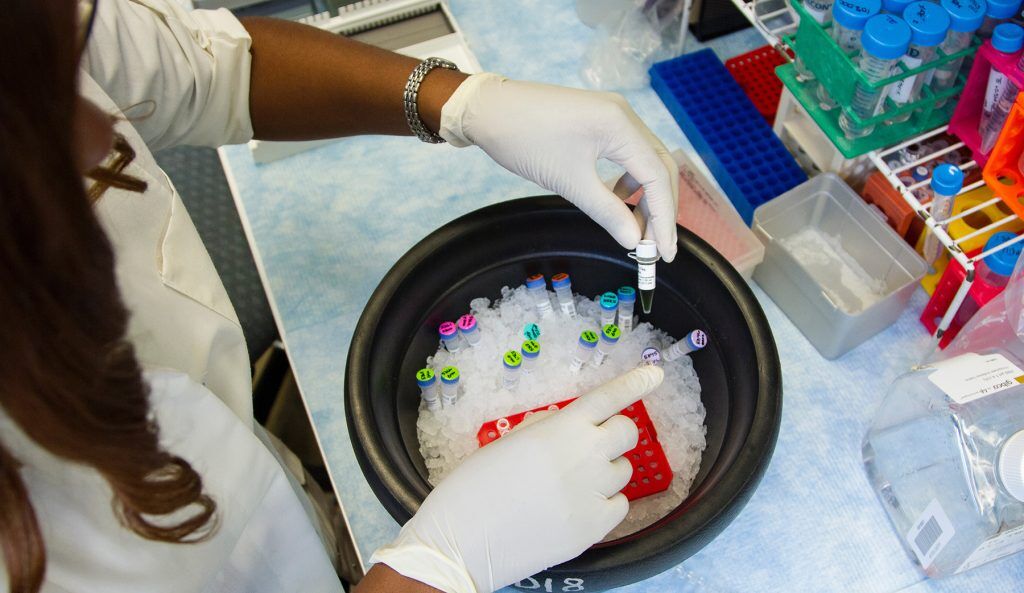BCRF-supported research is looking for better treatments for patients with TNBC.
Triple-negative breast cancer (TNBC) is very aggressive and fast-growing, with nearly no targeted therapies available today. TNBC represents 10 to 20 percent of diagnosed breast cancers and is more likely to affect younger people and those with a BRCA1 gene mutation.
The “triple-negative” in TNBC refers to the cancer cells lacking three key markers found in more common breast cancers: receptors for estrogen (ER), progesterone (PR), or HER2. Unfortunately, this means that TNBC will not respond to drugs that target ER, PR, or HER2, leaving women with this type of breast cancer with fewer treatment options.
But that landscape is changing. Recent discoveries from BCRF investigators and others have provided new insights into the molecular complexity of and potential targets for TNBC therapy. Using complex methods of molecular analysis, researchers have identified four distinct molecular subtypes of TNBC, each with a unique biology. These findings open the door for more effective treatment options. A few promising developments are highlighted here.
Rethinking hormone therapy in TNBC
Unlike ER-positive breast cancers, which have a very good prognosis because of targeted therapies that block ER-driven growth, TNBC does not depend on estrogen or progesterone, so it is not a candidate for these therapies. However, there is currently a renewed interest in a different hormone driver of TNBC—the androgen receptors (AR). While AR is typically associated with prostate cancer, it is often present in breast cancer cells. Evidence from ongoing clinical trials suggests that patients with AR-positive luminal-type (LAR) TNBC may benefit from anti-androgen drugs that are used to treat prostate cancer. BCRF is investing $10 million as part of its Drug Research Collaborative to advance our understanding of LAR TNBC and accelerate targeted therapies to the clinic.
Progress and challenges in immunotherapy
Most TNBC tumors fall into a category called basal-like. These are typically thought to be the most aggressive types of TNBC and are treated with chemotherapy. We now know that not all basal-like TBNC are the same. Based on the most recent classification, there are at least two types of basal-like TNBC—BL1 and BL2—and that the type of basal-like matters when it comes to treatment.
BL1 is most likely to respond to chemotherapy. In fact, patients with BL1-TNBC who respond well to chemotherapy often have a very good prognosis. BL2 TNBC are characterized by an immune signature that includes a high amount of immune cells in and around the tumor and a gene signature associated with immune functions. BL2 are predicted to be the most responsive TNBC to immunotherapies. This classification may help to explain why most patients with TNBC have not benefited from immunotherapy—and help identify those who will.
In 2019, the FDA approved the first immunotherapy drug for TNBC, atezolizumab, based on results from the Impassion130 study led by BCRF investigator, Leisha Emens, which showed a substantial survival benefit of atezolizumab combined with chemotherapy in patients with advanced TNBC. In partnership with the Parker Institute for Cancer Immunotherapy and Cancer Research Institute, BCRF is funding a study that will provide important information about how patients respond to immunotherapy to advance our understanding of who is likely to benefit, as well as strategies to improve response so more patients can benefit. This represents one of 55 projects BCRF is funding in immunology, 14 of which are focused on TNBC.
Understanding BRCA-mutated TNBC
About 70 percent of BRCA-mutated breast cancers are basal-like TNBC. Breast cancer cells that have a BRCA mutation can be targeted with a class of drugs called PARP inhibitors that work by blocking a DNA repair pathway on which BRCA-mutated cells depend on to survive. To date, two PARP inhibitors, olaparib and talazoparib, have been FDA-approved for people with advanced breast cancer and a BRCA mutation.
Even with this targeted approach, tumors develop resistance, making novel combination approaches an attractive option. Two phase II clinical trials combining PARP inhibitors and immunotherapy agents are underway: One is studying olaparib with atezolizumab and the other is studying talazoparib in combination with the immunotherapy drug avelumab.
TNBC is a varied and complex type of breast cancer, which is why BCRF is investing more than $21 million in research related to TNBC in 2019-20. Understanding the molecular classifications of TNBC and how best to target each one will bring us one step closer to making sure each patient receives treatment tailored to their specific TNBC subtype.
For information on clinical trials in triple-negative breast cancer, please go to breastcancertrials.org.
Related:
BCRF researcher Dr. Charles Perou shares advances in triple-negative breast cancer







